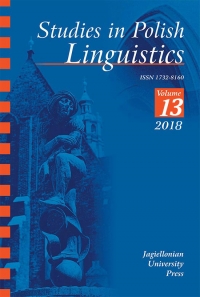Sandhi-Voicing in Dialectal Polish: Prosodic Implications
Sandhi-Voicing in Dialectal Polish: Prosodic Implications
Author(s): Ewelina Wojtkowiak, Geoffrey SchwartzSubject(s): Phonetics / Phonology, Sociolinguistics, Western Slavic Languages
Published by: Wydawnictwo Uniwersytetu Jagiellońskiego
Keywords: prosody; sandhi-voicing; Polish dialects; word boundaries; phonological representation; phonetics and phonology;
Summary/Abstract: Sandhi-voicing in dialectal Polish affects word-final obstruents in pre-sonorant and pre-vocalic environments. According to the standard descriptions, the process occurs irrespectively of the ‘underlying’ laryngeal specification of the consonant. The process has been problematic for phonological theory, with earlier accounts either requiring ad-hoc mechanisms to allow the ‘spreading’ of [voice], or providing an inadequate explanation of why the process is limited to word boundaries. In this paper, we test the hypothesis that sandhi-voicing dialects is a function of weaker word boundaries in the given dialects. Weaker boundaries go hand in hand with weaker initial syllables. We compare the speech of Standard Polish speakers (N=10) with speakers of the Poznań-Kraków dialect (N=10), who recorded sentences containing obstruent- sonorant sequences spanning word boundaries. We found acoustic evidence of weaker initial syllables for two prosodic parameters in the productions of dialect speakers. The relative strength of word-boundaries is described in the Onset Prominence model (OP; Schwartz 2010 et seq.), which also explains the role of manner of articulation in triggering the process.
Journal: Studies in Polish Linguistics
- Issue Year: 13/2018
- Issue No: 2
- Page Range: 123-143
- Page Count: 21
- Language: English

